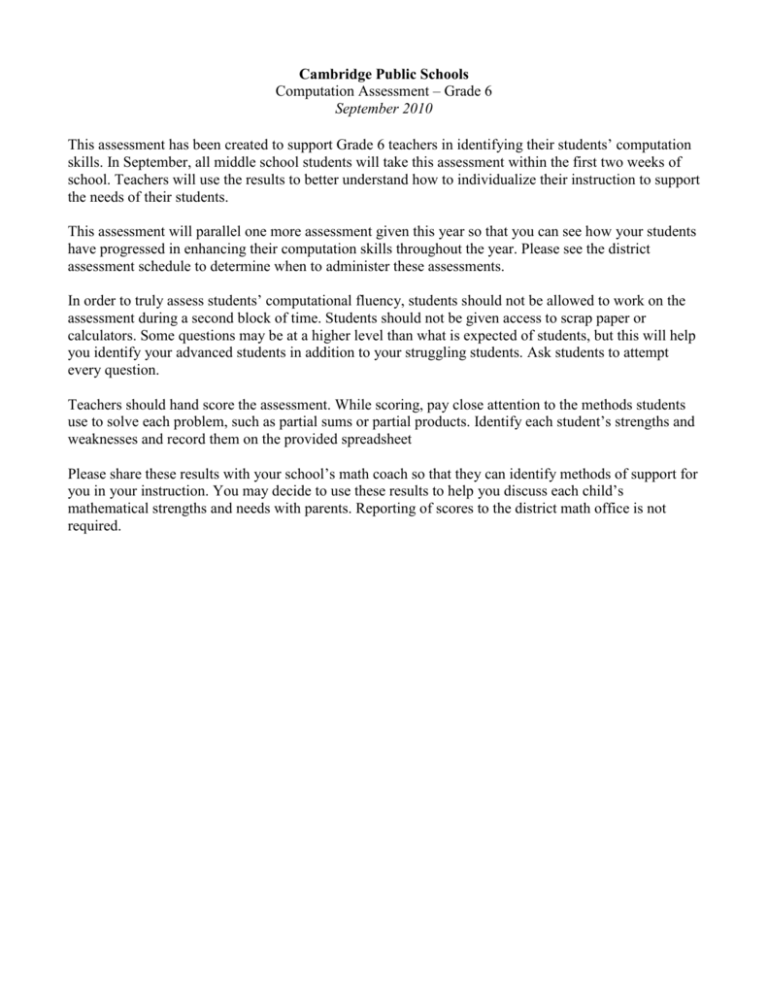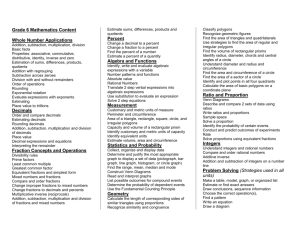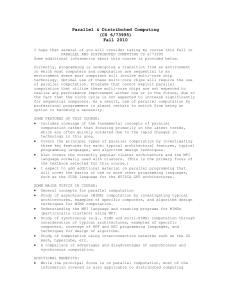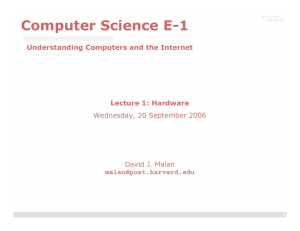Cambridge Public Skills - Cambridge Public Schools Moodle Site
advertisement

Cambridge Public Schools Computation Assessment – Grade 6 September 2010 This assessment has been created to support Grade 6 teachers in identifying their students’ computation skills. In September, all middle school students will take this assessment within the first two weeks of school. Teachers will use the results to better understand how to individualize their instruction to support the needs of their students. This assessment will parallel one more assessment given this year so that you can see how your students have progressed in enhancing their computation skills throughout the year. Please see the district assessment schedule to determine when to administer these assessments. In order to truly assess students’ computational fluency, students should not be allowed to work on the assessment during a second block of time. Students should not be given access to scrap paper or calculators. Some questions may be at a higher level than what is expected of students, but this will help you identify your advanced students in addition to your struggling students. Ask students to attempt every question. Teachers should hand score the assessment. While scoring, pay close attention to the methods students use to solve each problem, such as partial sums or partial products. Identify each student’s strengths and weaknesses and record them on the provided spreadsheet Please share these results with your school’s math coach so that they can identify methods of support for you in your instruction. You may decide to use these results to help you discuss each child’s mathematical strengths and needs with parents. Reporting of scores to the district math office is not required. Cambridge Public Schools Computation Assessment – Grade 6 ANSWER KEY WHOLE NUMBERS 1) 2) 3) 4) 5) 6) 7) 8) 9) 10) eight million seven hundred sixty five thousand nine hundred sixty five 9,754, 320 304,605 (5 × 1,000,000) + (6 × 100,000) + (7 × 10,000) + (1 × 10) 10,000,000 5,670 5,760 6,675 6,760 15 75 90 12 48 60 90 4 × 11 8–6+4 5.N.2 5.N.2 5.N.3 5.N.3 5.N.1 5.N.7 5.N.8 5.N.8 5.N.10 5.N.10 OPERATIONS ON WHOLE NUMBERS 11) 12) 13) 14) 15) 16) 17) 18) 19) 20) 15,166 108,104 7,516 70,884 350 25,758 1,952,808 45 900 463 5.N.12 5.N.12 5.N.12 5.N.12 5.N.12 5.N.12 5.N.12 5.N.12 5.N.12 5.N.12 OPERATIONS ON FRACTIONS AND DECIMALS 21) 2.75 22) 0.6; 60% 3 23) 5 1 24) 2 10 1 25) 9 2 1 26) 2 1 27) 4 1 28) 1 4 29) 18 30) 182.4 5.N.5 5.N.5 5.N.13 5.N.13 5.N.13 5.N.13 5.N.13 5.N.13 5.N.13 5.N.12 Cambridge Public Schools Computation Assessment – Grade 6 September 2010 Name: _______________________________________________ Class: ____________ This assessment is to help identify your strengths and weaknesses so that your teacher can better support you in their instruction this year. This assessment will not be counted towards your grade this year. As this assessment will help support you in meeting your mathematical goals this year, please record all your work and thoughts on the assessment. You will not have access to scrap paper or a calculator for this assessment. Whole Numbers 1) Write in words: 8,765,965 2) Using the digits 9, 4, 5, 0, 2, 3, and 7, write the largest number you can make. 3) Write the number that is represented below. 4) Write the number 5,670,010 using expanded notation. (3 × 100,000) + (4 × 1,000) + (6 × 100) + (5 × 1) 5) Write the number represented by 107. 6) Order the numbers from smallest to largest. 5,670 7) Circle the numbers below that are multiples of both 3 and 5. 3 9) 15 35 53 75 85 6+9 8+9 4 × 11 5 12 4 × 29 6,760 32 48 60 85 90 8 – (3 × 2) + 4 10) Circle the expression below that is equal to the above expression. 5,760 8) Circle the numbers below that are divisible by both 2 and 3. 90 4 × (2 + 9) 6,675 Circle the expression below that is equal to the above expression. 5×2+4 8–6+4 5×6 Operations on Whole Numbers 11) 4,528 + 136 + 95 + 10,407 = 13) 8,012 – 496 = 12) 14) 23,535 84,569 75, 673 4, 789 15) 25 × 14 = 17) 3, 432 569 19) 18,000 ÷ 20 = 16) 243 106 18) 225 ÷ 5 = 20) 8,797 ÷ 19 = Operations on Fractions and Decimals 21) Find the equivalent decimal for 2 23) 1 2 5 5 25) 3 4 1 6 10 10 3 . 4 22) Find the equivalent decimal and percent of 1 3 24) 1 2 5 26) 11 5 12 12 3 . 5 27) 1 1 2 4 29) 24 × 3 = 4 3 1 28) 4 3 = 4 2 30) 57 3.2











